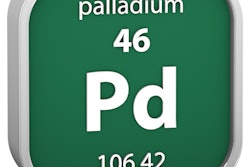Researchers from the California Institute of Technology (Caltech) have developed a metallic glass alloy that has demonstrated strength and toughness at a level not previously seen in any other material (Nature Materials, January 9, 2011).
The new damage-tolerant metallic glass -- a combination of the noble metal palladium, a small fraction of silver, and a mixture of other metalloids -- could soon find use in biomedical implants, according to Marios Demetriou, PhD, a senior research fellow at Caltech and lead author on the study.
"One example is dental implants," Demetriou said in a university press release. "Many noble metal alloys, including palladium, are currently used in dentistry due to their chemical inertness and resistance to oxidation, tarnish, and corrosion. Owing to its superior damage tolerance, the present palladium glass can be thought of as a superior alternative to conventional palladium dental alloys. Plus, the absence of any elements considered toxic or allergenic -- nickel, copper, aluminum -- from the composition of this alloy will likely promote good biological compatibility."
What gives metallic glasses their unusual qualities is the fact that they are made of metals but have the internal structure of glass, thus its strength and hardness.
The problem with trying to increase strength in ordinary metals is that their atoms are organized in a crystal lattice, Demetriou explained. "And whenever you try to make something as perfect as a crystal, inevitably you will create defects," he said.
Those defects, under stress, become mobile, and other atoms move easily around them, producing permanent deformations. While this rearrangement around defects results in an ability to block or cap off an advancing crack, producing toughness, it also limits the strength of the material.
On the other hand, glass has an amorphous structure, its atoms scattered about without a specific discernible pattern. In metallic glasses this results in an absence of the extended defects found in crystalline metals. The actual defects in glasses are generally much smaller in size and only become active when exposed to much higher stresses, resulting in higher strengths. However, this also means that the strategy used in ordinary metals to stop a crack from growing ever longer is not available.
In the new palladium alloy, so many shear bands form when the material is put under stress that it "actually leads to higher toughness, because the bands interact and form networks that block crack propagation," Demetriou explained. In other words, the number of shear bands that form, intersect, and multiply at the tip of an evolved crack is so high that the crack is blocked and cannot travel very far. In essence, then, the shear bands act as a shield, preventing shattering. Thus, the palladium glass acts very much like the toughest of steels, using an analogous blocking mechanism of arresting cracks.
"This high toughness does not come at the expense of strength," Demetriou added. "This material has both strength and toughness, which is why it falls so far outside what's previously been possible. That's why this material is so special."
Copyright © 2011 DrBicuspid.com



















